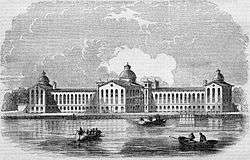New York House of Refuge

The New York House of Refuge was the first juvenile reformatory established in the United States.[1] The reformatory was opened in 1824 on the Bowery in Manhattan, New York City,[2] destroyed by a fire in 1839, and relocated first to Twenty-Third Street and then, in 1854, to Randalls Island.[3]
Through its 111-year history the reformatory was privately funded, receiving only guidance, supervision and additional funding from state agencies.
History
The concept of a youth detention center came from Cadwallader Colden, John Griscom, Thomas Eddy, and Stephen Allen with the Society for the Prevention of Pauperism. In 1820 the society surveyed United States prisons and issued a report in 1824. The report called for the creation of a reformatory for juveniles to segregate them from adult prisoners.[1]
One of the center's inmates was Austin Reed, whose posthumously published memoir The Life and Adventures of a Haunted Convict recounted, in part, his tenure in the institution in the 1830s.[4]
The institution drew acclaim from touring French prison reformers Gustave de Beaumont and Alexis de Tocqueville in 1831, and writer Charles Dickens, who described it approvingly in his 1842 American Notes.[5]
Architect and construction engineer R.G. Hatfield (1815 - 1879) designed the House of Refuge's vast new 1854 building on Randalls Island, following a fire at the previous Manhattan location. [6]
Beginning in 1901 female inmates were removed to the newly-opened New York State Reformatory for Women, now the Taconic Correctional Facility. In the 1930s, younger male inmates (ages 12 to 15) were transferred to the new state training school at Warwick, and the older boys to the newly constructed state prison in Coxsackie. [7] The House of Refuge closed permanently on May 11, 1935.
References
- 1 2 "New York House of Refuge". New York State Archives. Retrieved 2011-05-05.
The New York House of Refuge was the first juvenile reformatory in the nation. ...
- ↑ https://yalealumnimagazine.com/articles/3841
- ↑ http://www.nytimes.com/1860/01/23/news/our-city-charities-the-new-york-house-of-refuge-for-juvenile-delinquents.html?pagewanted=all.
- ↑ http://news.yale.edu/2013/12/12/first-known-prison-narrative-african-american-writer-discovered-yale-s-beinecke-library
- ↑ Stepenoff, Bonnie (24 May 2010). The Dead End Kids of St. Louis: Homeless Boys and the People Who Tried to Save Them. University of Missouri Press. p. 56. Retrieved 6 October 2016.
- ↑ Kidder, Frank Eugene (1904). The Architect's and Builder's Pocket-book: A Handbook for Architects, Structural Engineers, Builders, and Draughtsmen. J. Wiley & Sons. p. 1546. Retrieved 7 October 2016.
- ↑ Eisenstadt, Peter R.; Moss, Laura-Eve (2005). The Encyclopedia of New York State. Syracuse University Press. p. 1088. Retrieved 6 October 2016.
External links
Coordinates: 40°47′42″N 73°55′23″W / 40.795°N 73.923°W